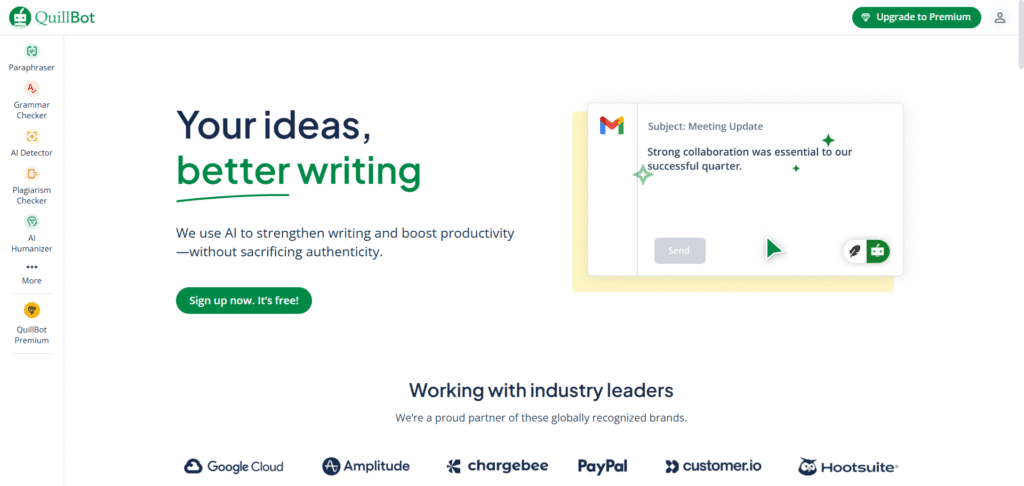When asked about Quillbot vs Grammarly in research, sorry Grammarly, but hands down, Quillbot wins. Need to turn a mountain of notes into a neat summary? Struggling to reword sources without losing meaning? Quillbot handles it all in minutes, sparking ideas and saving hours of tedious work. Grammarly is still helpful for cleaning up grammar and catching plagiarism, but here’s the catch: it won’t generate ideas or rephrase content for you. If your goal is to actually get your research done faster and smarter, Quillbot is the real MVP.
Picture this: it’s 11 pm, your essay deadline is tomorrow, and your desk is buried in scattered notes and half-read articles. You’re trying to summarise, paraphrase, and polish everything before your brain officially melts. Enter Quillbot — in just a few clicks, your 10-page source is now a sharp, 300-word outline, and you’re back in control. Grammarly can tidy the language later, but Quillbot is the one that keeps your research moving. According to a 2024 EdTech survey, 70% of researchers now rely on AI tools to cut writing time, showing just how essential these platforms have become.
Core Features: Quillbot vs Grammarly
Both Quillbot and Grammarly aim to make writing easier, but they take very different approaches when it comes to research tasks. Quillbot is designed to help you generate ideas, rephrase content, and summarise long sources quickly, while Grammarly focuses on polishing your writing, catching errors, and maintaining academic integrity. Understanding their core features can help you decide which tool to lean on at different stages of your research workflow.
Quillbot’s Paraphrasing Strengths
Quillbot truly shines when it comes to rewriting text in multiple styles. This is especially useful for avoiding plagiarism, giving your work a fresh voice, and condensing complex material into digestible chunks. Its summariser feature can transform long articles or research papers into concise key points, making it easier to extract the insights you need without manually combing through pages of content.
Example: Imagine a history student facing a 10-page journal article. Using Quillbot, they can turn it into a clear, 300-word outline in just minutes, saving hours of tedious summarising.
Key features of Quillbot include:
- Multiple paraphrasing modes: Standard, Fluency, and Creative, allowing users to adjust the level of rewriting to match their needs.
- Summarisation tool: Quickly condenses articles, research papers, and notes into core points.
- Integration with word processors: Copy, paste, or draft directly in Quillbot for a smoother workflow.
- Vocabulary enhancement: Suggests alternative words or phrasing to make content more engaging and precise.
These features make Quillbot particularly useful during early-stage research, brainstorming sessions, or when you need to generate multiple versions of a text for analysis.
Grammarly’s Editing Edge
Grammarly, on the other hand, focuses on refining your writing. It highlights grammar mistakes, clarity issues, tone inconsistencies, and even plagiarism concerns, making it a valuable tool for the final stages of paper preparation. Its real-time suggestions help ensure your research is professional, readable, and academically sound.
Case study: A science research team used Grammarly to correct citation errors and polish the language in a technical report, saving two days of revisions and avoiding potential submission errors.
Key features of Grammarly include:
- Real-time grammar and style suggestions: Automatically detects and fixes errors, from punctuation to sentence structure.
- Tone detection: Ensures your writing matches the intended audience, whether academic, professional, or casual.
- Plagiarism checks: Compares your work against billions of online sources to maintain originality.
- Clarity-focused recommendations: Helps restructure complex sentences for better readability.
Grammarly is best suited for final editing, ensuring your research reads smoothly and meets academic standards. While it won’t generate new content or summaries, it prevents errors that could undermine the credibility of your work.
Overlap and Gaps in Research Use
While both tools can handle basic proofreading and minor edits, their strengths diverge when it comes to research-heavy tasks. Quillbot excels at content creation and summarisation, helping you transform raw notes into structured insights quickly. Grammarly excels at precision, catching errors, and enhancing readability, but it lacks the creative rephrasing capabilities that Quillbot offers.
As Dr Lena Torres, an AI writing specialist, explains, “Quillbot transforms raw data into fresh insights quicker, while Grammarly ensures the final draft is polished and publication-ready.”
By combining these tools strategically, you can cover both creative generation and final accuracy, making your research process faster, more efficient, and less stressful.ins, “Quillbot transforms raw data into fresh insights quicker.” Grammarly ensures precision, but remember — it won’t create new ideas or reword content creatively.
User Experience and Ease of Use: Quillbot vs Grammarly
Long research sessions demand tools that are intuitive, responsive, and easy to navigate. When your brain is juggling multiple sources and deadlines are looming, the last thing you want is a clunky interface or complicated setup. Both Quillbot and Grammarly shine in different ways, depending on how you work.
Interface and Accessibility
Quillbot is designed for simplicity. Its clean, minimalist dashboard allows users to paste text, select paraphrasing modes, or summarise long articles with just a few clicks. You don’t need to navigate through endless menus—everything you need is front and centre, making it perfect for quick brainstorming or tackling a mountain of notes.
Grammarly, meanwhile, excels at integration and workflow flexibility. It works seamlessly with browsers, Google Docs, Microsoft Word, and even desktop applications. This means you can edit emails, draft papers, or polish essays without leaving your preferred workspace. While Grammarly’s interface is slightly more feature-packed, it keeps suggestions visible and actionable, ensuring you don’t miss critical edits.
Actionable tip: Start with the free versions to test mobile accessibility and integration options. This helps you see which tool fits your workflow before committing to a subscription.
Learning Curve for Researchers
Quillbot is quick to learn, especially for paraphrasing and summarising. New users can grasp its core features in under 10 minutes, making it ideal for students or researchers who need results fast. Its intuitive layout reduces friction, allowing you to focus on ideas rather than the tool itself.
Grammarly may take a bit longer to master, especially if you dive into advanced features like style guides, vocabulary suggestions, and tone detection. However, its tutorials and prompts make it approachable, even for beginners. Once familiar, users can leverage Grammarly to catch subtle errors, enhance readability, and ensure professional-quality outputs.
Quick wins for research efficiency:
- Use Quillbot for brainstorming, paraphrasing, and summarising notes quickly.
- Rely on Grammarly for final edits, polishing language, and checking citations.
- Studies indicate users can save up to 25% of drafting time when combining these AI tools effectively (2025 productivity study).
Real-User Feedback
Feedback from researchers and writers highlights the complementary strengths of each tool:
- Quillbot users consistently report a creativity boost, with one blogger claiming a 40% reduction in writer’s block. It helps transform raw ideas into structured content, reducing the stress of staring at a blank page.
- Grammarly is praised for accuracy and precision, ensuring drafts are clean, coherent, and publication-ready. Some users, however, find its suggestions rigid or overly prescriptive, which can slow down creative writing.
Overall, the user experience is about choosing the right tool for the right task. Quillbot keeps ideas flowing and research moving, while Grammarly ensures that your final product is polished, professional, and error-free.
Pricing and Value for Research Needs: Quillbot vs Grammarly
When it comes to choosing the right research tool, understanding cost versus benefit is crucial—especially for students, early-career researchers, or anyone working with a tight budget. Let’s break down how each tool stacks up in terms of pricing, ROI, and long-term value.
Free vs Paid Plans
Quillbot offers a free tier that allows up to 125-word paraphrases, giving you a taste of its summarising and rewriting capabilities. For heavy research tasks, the premium plan costs $9.95/month and unlocks unlimited paraphrasing, full access to the summariser, and advanced writing modes.
Grammarly, by contrast, provides a free version covering basic grammar and spelling checks. Its premium plan costs $12/month and adds advanced features such as tone detection, style guides, and a plagiarism checker.
Affordability is a major consideration for academics: according to a 2024 Higher Ed Review, 60% of researchers prefer tools under $10 per month. This makes Quillbot a highly budget-friendly option for research-heavy tasks, while Grammarly may be better suited for those prioritising polished, error-free writing.
ROI for Research Tasks
Quillbot delivers strong value for idea generation and content creation. For example, one thesis writer reported cutting research hours by 30% by using Quillbot to summarise sources and rephrase complex material quickly. This is particularly valuable during early-stage research or when tackling large volumes of reading.
Grammarly, on the other hand, shines in quality control. It prevents submission errors, fixes grammar issues, and ensures clarity, making it a great tool for final edits and maintaining academic integrity.
Actionable takeaway: If your focus is rewriting, summarising, and generating ideas, budget for Quillbot. If your goal is polishing, error-proofing, and finalising documents, Grammarly is worth the investment. Combining both can maximise productivity.
Long-Term Scalability
Both platforms scale to team or enterprise accounts, but they serve different needs. Quillbot is ideal for individual researchers or small groups looking for fast content generation. Grammarly’s enterprise plans are better for collaborative research projects or institutions where consistency, tone, and error-free output across multiple users are critical. Productivity expert Mark Reilly notes, “Value comes from time saved, not just features,” highlighting the importance of matching the tool to your workflow.
Pros, Cons, and Best Scenarios: Quillbot vs Grammarly
Quillbot’s Advantages and Limits

Pros:
- Boosts originality and creativity
- Excellent for summarising literature and notes
- Speeds up drafting and brainstorming
Cons:
- Limited grammar and punctuation corrections
- Not a replacement for final editing
Best for: Early-stage research, summarising long sources, drafting outlines, or generating multiple versions of content.
Grammarly’s Strengths and Drawbacks

Pros:
- Produces polished, professional drafts
- Strong support for non-native English writers
- Plagiarism checker adds an extra layer of security
Cons:
- Weaker at creative rephrasing
- Won’t generate content or summaries
Best for: Final edits, citation checks, technical writing, and preparing documents for submission.
Head-to-Head Verdict
- Speed: Quillbot takes the lead for fast rewrites and summarising large sources.
- Accuracy: Grammarly wins when it comes to error-free output and polished drafts.
- Overall: Quillbot edges out for research creativity and content generation, while Grammarly shines for precision and professional presentation.
Conclusion
For dynamic research tasks, Quillbot is the winner, helping generate ideas, summarise sources, and turn hours of work into minutes. Grammarly remains essential for polishing and error-proofing final drafts, but its creativity limitations mean it’s best used after Quillbot has done the heavy lifting. The smartest approach? Combine both tools to save up to 50% of writing time. Try their free versions and see which fits your workflow. Share your experiences in the comments and start optimising your research process today.
If you found this comparison helpful, why stop here? There’s a whole world of AI tools out there that can make research writing faster, smarter, and even more enjoyable. Check out our 10 Best Free AI Tools for Research Writing to discover tools that can summarise papers, organise notes, generate citations, and boost your productivity without costing a penny. Whether you’re looking for more ways to save time or want to experiment with new AI-powered assistants, this guide is the perfect next step to supercharge your research workflow.

